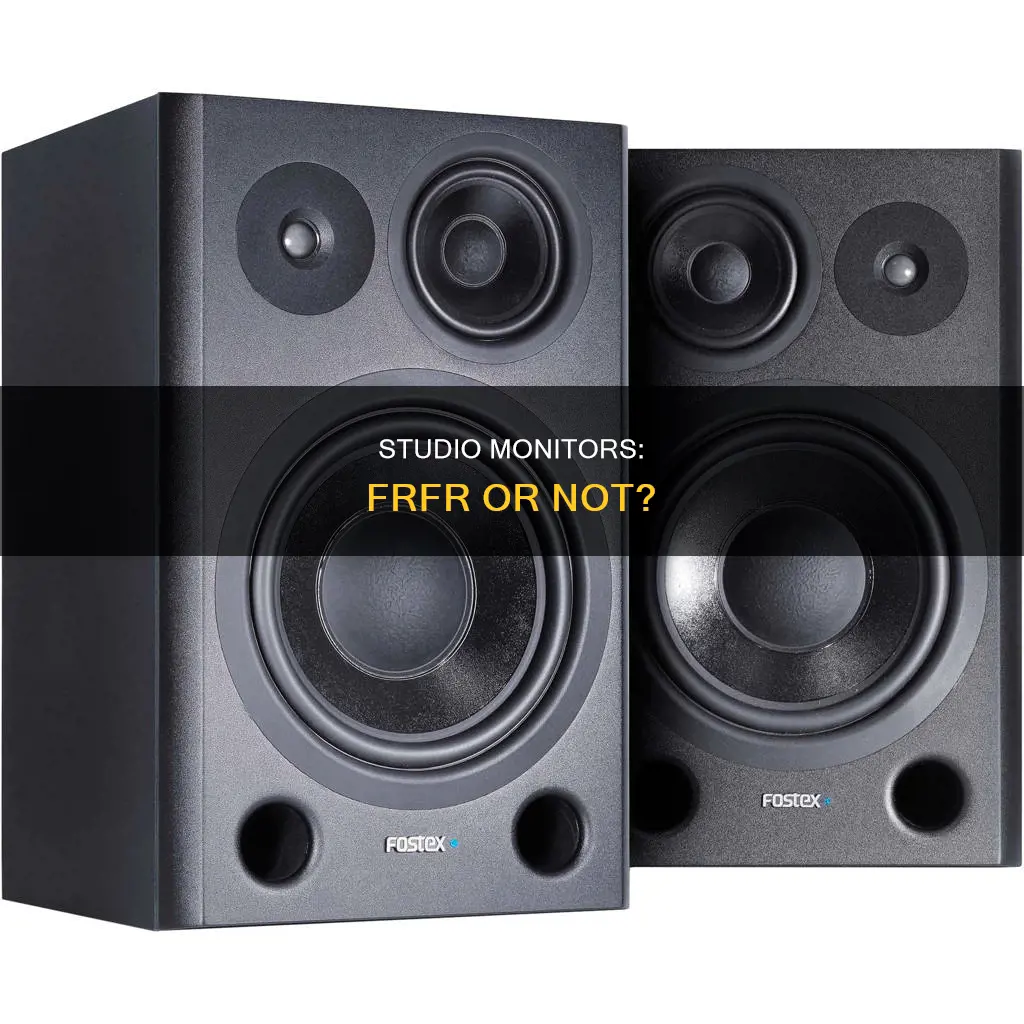
Studio monitors and FRFR speakers are both used to listen to music, but they have different purposes and characteristics. Studio monitors are typically used for recording and mixing music, as they provide a flat response and accurate sound. On the other hand, FRFR (full-range, flat-response) speakers are similar to PA speakers and are often used for live performances or monitoring. They aim to recreate the amp in a room response that guitarists seek. While some people prefer the extended highs and articulation of FRFR speakers, others opt for studio monitors for their accuracy and versatility. Ultimately, the choice between the two depends on the user's specific needs and preferences.
| Characteristics | Values |
|---|---|
| Purpose | Studio monitors are used for recording and mixing, while FRFRs are used for live performance, monitoring, and practice. |
| Sound | Studio monitors have a flat response, while FRFRs aim for neutrality and can deliver an "amp in a room" response. |
| Volume | Studio monitors may not have enough volume for live performances, while FRFRs have more headroom and can provide higher volumes. |
| Features | FRFRs have guitar-centric features like onboard speaker IRs and toggle-able EQ sections. |
| Design | FRFRs often resemble traditional guitar cabinets in design and may be made from birch. |
| Usage | Studio monitors are typically used in a studio or bedroom setting, while FRFRs can be used for live performances and as stage monitors. |
| Mic Usage | Studio monitors are not typically mic'd, while FRFRs can be mic'd in certain situations, such as recording, to capture an "amp in a room" sound. |
What You'll Learn

Studio monitors are already pretty flat in their response
FRFR stands for "full-range, flat-response." These speakers aim to be as neutral as possible, serving as a blank canvas for the sounds produced by a modeling device. They are self-contained systems that resemble PA speakers more than traditional guitar cabinet setups, with built-in power amplifiers and 2-way speaker systems. FRFRs are designed to re-create the look and form factor of a traditional guitar cabinet, and some are even made from birch, a premium tonewood in the guitar cab market. They also have a range of guitar-centric features, such as onboard speaker IRs and toggle-able full-range/cab-filtered EQ sections.
While studio monitors are already pretty flat in their response, FRFR speakers take this a step further. FRFR speakers are designed to deliver a clean and neutral tone with plenty of headroom. They have more power and can handle higher volumes without clipping. This makes them a better option for live performance and monitoring, especially if you need to fill a larger venue. However, they may be overkill for bedroom use, as studio monitors are typically more than sufficient for this purpose.
In terms of audio quality, studio monitors can provide better audio quality at a lower price point. This is because the manufacturers don't need to spend as much money making them rugged and gig-loud. Studio monitors are also more versatile, especially if you plan on doing some recording. They are great for sitting in the sweet spot, but if you want a wider dispersion and potential volume, an FRFR speaker might be a better option.
Ultimately, the decision between studio monitors and FRFR speakers depends on your specific needs and preferences. If you are a bedroom player who doesn't need the extra volume and dispersion, studio monitors are probably the best option. If you plan on playing live or need to fill a larger space, an FRFR speaker might be a better investment.
Business Performance Monitoring: Strategies for Success
You may want to see also

FRFRs are designed to be used live
FRFRs are typically marketed directly to guitarists and are designed to look like classic guitar amp or speaker cabs. They are built from materials commonly used in guitar cabs, like birch wood. FRFRs have built-in power amplifiers, which are almost always solid state, and are designed to have no unique audio flavour or texture. This means that the frequency response of the amplifier is flat, and the speakers themselves add no colour, fall-off, or boost throughout the delivery range.
FRFRs are perfect for musicians who want to experiment with different amp tones without investing in an extra cab. They are also much simpler to use than traditional speakers; musicians can quickly set up their instruments without worrying about microphone placement or stage setup. This allows them to achieve a neutral output studio-perfect sound in seconds.
However, FRFRs do have some limitations when it comes to live music. Due to their design, they don't move air like traditional cabs and may not be able to create the same impact. For this reason, many rock or metal bands use modelling amps while still incorporating guitar cabs. Additionally, the sound produced by FRFRs can sometimes be a bit isolated and bare, lacking the presence and warmth of traditional speakers.
Despite these limitations, the convenience and utility of FRFRs have made them increasingly popular, especially when paired with amp profilers or modelers. They are highly versatile and allow musicians to achieve the same sound regardless of the venue.
Disassembling LG LCD Monitors: A Step-by-Step Guide
You may want to see also

Studio monitors are more versatile
Studio monitors are also a better option for those who are just starting out with guitar, as they are more useful overall and are great for bedroom players. They are also more affordable and can deliver excellent results, especially if you invest in proper monitor placement and some basic room acoustic treatment.
If you are looking to improve your setup, studio monitors are a good choice as they provide better audio quality for the price. This is because manufacturers don't need to spend money making them rugged and gig-level loud.
Studio monitors are also a good option if you are thinking of recording in the future. They are FRFR and, although stage monitors are also FRFR, they sacrifice some accuracy for volume and dispersion.
Overall, studio monitors are a more versatile option than FRFR speakers. They are suitable for a range of applications, including recording, mixing, and casual listening. They are also more affordable and can deliver excellent results with the right setup.
Repairing Dead Pixels on an LCD Monitor: A Step-by-Step Guide
You may want to see also

FRFRs are more rugged and gig-loud
FRFR stands for Full Range Flat Response. They are designed to deliver a neutral sound, acting as a blank canvas for the sounds produced by modelling devices. They have built-in power amplifiers and are solid-state, with no unique audio flavour or texture. This means that the frequency response is flat, and they do not colour the sound.
FRFRs are also more powerful than studio monitors. They need this extra power to deliver clean and neutral tones, and to ensure that the guitar signal does not suffer. This extra power means that they can also be used as part of a PA system, whereas studio monitors often lack the required volume and dispersion.
FRFRs are designed to be heard, to feel the music, and to deliver an "amp in the room" experience. They are built to be rugged and loud, and their design reflects this. They are a great choice for those who want to be able to use their speakers live and in the studio, and their power and versatility make them a good investment.
Studio monitors, however, are more detailed and accurate. They are designed for a more controlled environment, where their sweet spot can be utilised. They are a great choice for those who want the best possible audio quality for their home studio or bedroom setup. They are also a more affordable option, and for those who are not planning to play live, they are the better choice.
In summary, FRFRs are more rugged and gig-loud, with powerful and versatile performance capabilities. Studio monitors, on the other hand, offer detailed and accurate audio reproduction in a controlled environment. The best choice depends on the user's needs and preferences.
Choosing the Right Monitor for Photo Editing Like a Pro
You may want to see also

Studio monitors are better for lower volumes
Studio monitors are better suited for lower volumes, and there are several reasons why. Firstly, studio monitors are designed for near-field monitoring, meaning they are meant to be listened to at a very close distance, typically between three to five feet away. This close proximity allows for more accurate imaging and balance across the frequency spectrum. At lower volumes, our perception of sound changes, and we may not be able to hear certain low and extremely high frequencies. Studio monitors, with their precise response, help compensate for these perceptual differences at lower volumes.
Additionally, listening at lower volumes can reduce ear fatigue and protect your hearing. Our ears and brain automatically adjust to the general sound level in the environment, and cranking up the volume can lead to auditory adaptation, where we reach for the volume knob again and again to compensate. By mixing at lower volumes, you can maintain a comfortable listening level while still being able to pick out finer details in the music.
Studio monitors also tend to provide better audio quality at lower volumes compared to FRFR speakers. This is because studio monitor manufacturers focus on audio quality rather than making their speakers rugged and gig-loud. As a result, studio monitors offer a more accurate and less distorted sound, even at lower volumes.
Finally, when it comes to convenience and cost-effectiveness, studio monitors excel at lower volumes. With studio monitors, you can dial in excellent tones for your music without needing to invest in additional equipment. They are versatile and can be used for both personal listening and recording, making them a more economical choice.
In summary, studio monitors are better for lower volumes due to their near-field design, ability to compensate for perceptual differences, reduced ear fatigue, superior audio quality, and convenience. Whether you are a hobbyist or a professional, studio monitors at lower volumes can provide an accurate and enjoyable listening experience.
Finding Proview Monitor Model Numbers: A Simple Guide
You may want to see also
Frequently asked questions
FRFRs (Full-Range, Flat-Response) speakers are self-contained systems that resemble PA speakers, with built-in power amplifiers and 2-way speaker systems. Studio monitors, on the other hand, are typically used for recording and mixing and are designed to provide a flat response.
It depends on your use case. If you are a bedroom player or primarily recording and mixing, studio monitors should be sufficient. However, if you plan to play live or need amplification, an FRFR would be a better option as they are designed for live sound production and can provide more volume.
Some popular FRFR speakers include the HeadRush FRFR-112, Mission Engineering Gemini 2, ISP Technologies Vector FS8, Friedman ASC-12, and Line 6 PowerCab 112 Plus. These options offer features such as high power output, stereo operation, and traditional cabinet look.
It depends on your preference. Some players prefer the extended highs and articulation of FRFRs, while others prefer the sound of a traditional guitar speaker and cabinet. If you choose to use a traditional setup with your modeling device, you will need a specialized outboard power amp and disable cabinet emulation in your device.
It is generally not recommended to mic an FRFR speaker as it can colour the signal in unflattering ways. However, there may be times when miking an FRFR can be advantageous, such as in a recording environment to capture the "amp in a room" sound.







